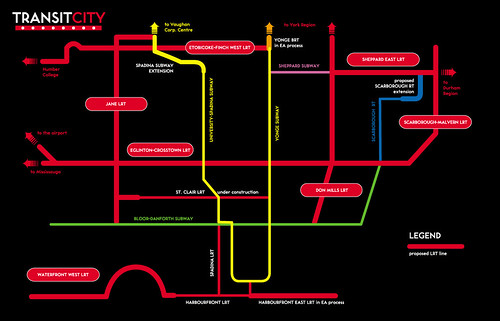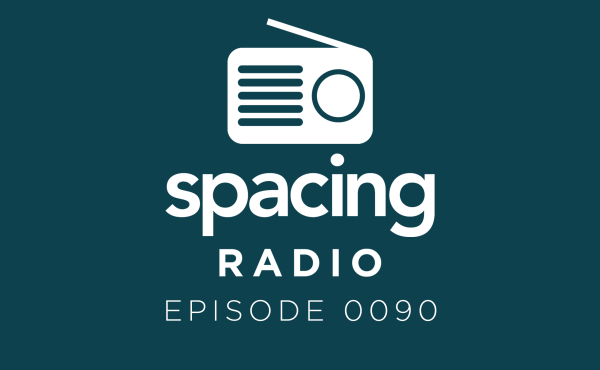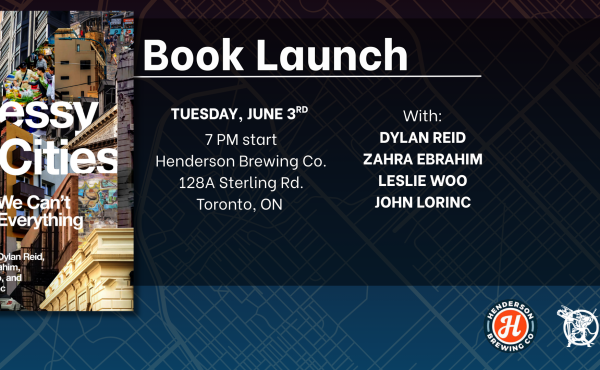

Why subways are not better
Toronto’s transit geeks are drooling over newly released plans to build an integrated network of LRT lines that criss-cross the city and go into its most neglected corners. But ask the average Torontonian how to best improve the city’s public-transit service and they’ll scream “build more subways!â€
Despite the subway’s undeniable allure, transit experts have been calling for a comprehensive plan like the LRT network outlined in Transit City for years. One of the best places to learn more about it (and Toronto transit in general) is www.stevemunro.ca, the blog of well-known transit guru and Jane Jacobs Prize recipient Steve Munro, who along with the group “Streetcars for Toronto†(which formed in 1972 and disbanded in the ’80s), helped keep streetcars at the heart of Toronto’s transit network. Needless to say, the release of Transit City left him giddy with excitement.
“Today was an event I’ve been waiting for, although I never really expected to see it,†Munro writes on his blog. “This is an LRT plan on a scale and with the political support we should have had 30 years ago.â€
While the general public bemoans the lack of subway tunnels in the plan, why do the transit geeks insist LRTs are a better plan? Here are a few reasons:
You get more bang for your buck. The 8.7 km Spadina subway extension to Vaughan is projected to cost $2.1 billion, bringing with it 30 million new riders. At $6.1 billion, fulfilling the Transit City plan may cost three times the dough, but it will be 13 times longer (120 km), and attract a projected 100 million new riders.
LRT routes can be built much faster. Our inner suburbs need faster, more reliable service — or just any service at all — now. A mere 19 percent of all trips made on the TTC take place in the suburbs.
LRT is the right size. We don’t have the capacity to fill new subway routes (see: the Sheppard line). Toronto is much more spread out than, say, New York, which has the kind of complex subway network many Torontonians would like to see here. They also have more than twice the population density. Even if a fairy came along and magically built us a new subway system today, we’d soon go broke operating it — there simply aren’t enough people outside the downtown core to fill it yet.
As TTC Chair Adam Giambrone has pointed out, building LRT routes does not mean an end to subways. “What you want to do is build a case for subways by growing ridership,†he says.
Billoards on wheels to get the boot?
If Toronto is seriously committed to tackling climate change (and ad creep), getting rid of mobile billboards — those trucks that serve no purpose other than attracting our eyes to the ads they tow — should be a no-brainer. Howard Moscoe has asked staff to draft a bylaw that would make mobile billboards illegal. “They have no redeeming value,†says Moscoe. “They burn gas and pollute the air.â€




20 comments
What about an East West Subway downtown? Surely the better way is a Subway somewhere between King and Queen to take the pressure off. The streets are too narrow for an ROW solution.
It’s a good plan but not a great plan – in fact to refer to it as a plan is being generous – it’s more of a sketch really, given there’s no money for it.
Much more community input is needed. It has been badly sold, since the media were not told to emphasis that LRT would be new and mobility-friendly vehicles unlike current streetcars, leading to critical letters to newspapers from those familiar with the current, unsuitable cars. Selling this plan to Torontonians and other GTA residents is critical to obtaining federal and provincial dollars, and must avoid an Ottawa O-Train-like fiasco.
Steve Munro being a streetcar activist is obviously delighted but those would favour at least some more subway building (extensions to Downsview and Scarborough to make the Sheppard line worth riding, for instance) rather than the enforced changes to buses and LRT should not be lightly dismissed.
The choice of mode should have been left to the Environmental Assessment, instead merely identifying avenues but LRT is proposed as a one mode fits all solution, especially when attempts to make an LRT line at Spadina, Queens Quay and St Clair have met with only limited improvement and near-sabotage by Toronto Roads Department.
Worryingly, the plan does not speak to remedying the poor performance of downtown streetcar lines – the Queen line could do with the underground section being proposed for the Eglinton LRT.
While I agree with a number of Mark’s comments, Transit CIty is about the growth of the network, not fixing/planning current projects like Kingston Rd streetcar or the debacles of KIng and Queen. As you might have seen, King streetcar issues were addressed yesterday at the Commission meeting.
As someone who was at the announcement, there was a clear distinction made to the media between streetcars and LRT. But outlets like the Tor SUn and all those horrible AM radio stations decided not to pay attention. Because the Spadina and St Clair lines are called LRT they assume its the same (which is certainly the TTC’s fault for calling those lines LRT).
There used to be a plan for a Queen Street subway; in fact, under the Bay store at Yonge there is a “ghost station” that was to be the transfer point for this very good idea that never got built.
I’ll tell you why the “average Torontonian” says,”Build Subways.” It’s because the average Torontonian currently driving his/her car around the city outside the downtown core will not abandon it for a streetcar, no matter”fast” it travels. This is a huge city and to get from a suburban location to downtown you need something that moves quickly and is comfortable. Steetcars do not have these qualities no matter what you do to them. Streetcars are a romantic preoccupation of certain inner city dwellers who never regularly have to travel the immense distances outside the downtown core. For once, it would be nice for someone to have some real vision and start building an extensive subway system. Float bonds, borrow the money. We’ll have to do it in the end inevitably.
Brian
this plan is not to put streetcars out into the burbs: its about putting fast-moving LRTs, that have stops spaced apart 500 metres or more.
You obviously have no idea about economics and how development effects the usage of subways. The burbs don’t have the density to support subways, When they do they will get them. Until then, LRTs will have to do as they will serve the same purpose and will be nearly as fast.
And you have no idea how people’s psychology works. This economic/density argument completely ignores a whole raft of factors that affect what type of transportation real people use. This is a stop-gap measure which is unlikely to be particularly popular with huge numbers of people who would rather be in their cars in a traffic jam than waiting at a cold, windy corner for a streetcar(and it is that no matter what you call it). Subways are expensive but they work extremely well and tend to be a far preferred mode of transport. We just lack the will to take a bold move, but that’s very Toronto.
I think it is important to look at growth. I like the LRT idea, however people keep claiming that it’s just a stepping stone to future subway lines.
If the city believes an area will expand to the point where subways will become necessary, it might be better to install those subways before the area gets built up. I would think digging a tunnel in vacant land would be cheaper than tunnelling under skyscrapers.
Which would be more costly?
A) Building a subway line now in an unbuilt up corridor & take the hit on lack of riders.
B) Building a LRT line now, PLUS build a more costly subway line once the LRT line can’t handle the traffic.
The problem I see with B (Other than the cost), is that nobody will want to take the step from LRT to subway when it becomes necessary. The LRTs will end up packed beyond capacity, with constant delays and problems.
Which makes the issue of the King, Queen and Lakeshore streetcar lines completely valid. If this plan is to go through the city needs to make sure they don’t end up giving us a more expensive problem in the end. Dismissing the King, Queen and Lakeshore lines as hopeless might not be the best way of looking at things.
Any new extensive subway plans would get killed even if the current mayor did take a bold move. Miller’s next opponent could probably win the 2010 election (and stop the project) by stating that the city’s finances were in shambles due to enormous (and irresponsible) spending that would encompass such a project.
Has thought been given to removing parking on Queen Street to free up space for a dedicated transit lane? Is it simply too complicated to implement?
“The problem I see with B (Other than the cost), is that nobody will want to take the step from LRT to subway when it becomes necessary.”
Why not? The Bloor-Danforth was originally a streetcar line. No reason it couldn’t happen again.
“Billoards on wheels to get the boot?”
It’s about time. I almost got run over by one of those vehicles while walking at my university campus. It’s just useless and a health hazard in so many ways.
The problem with giving up downtown street parking is the condo boom. Take King Street West – the TIFF building will stand on what’s currently a car park. Where are those cars going to go? Street parking. But if you take street parking away, where then – this is the question vendors in the area are asking according to media coverage of the TTC proposal.
The answer will have to be twofold – redirection to more reliable *and larger* King trams and at least a few multistory car parks to deal with the remaining parking demand.
Chairman Giambrone has talked about a Metropass Affinity Plan. Other people are already doing it (http://www.themap.ca) but with TTC endorsement theatres on King could offer discounts etc. The important thing is that the TTC does not scrimp on capacity – if the people choose transit it must be there for them to use.
“Which would be more costly?
A) Building a subway line now in an unbuilt up corridor & take the hit on lack of riders.
B) Building a LRT line now, PLUS build a more costly subway line once the LRT line can’t handle the traffic.”
The answer is C) Building nothing because people demand subways that can’t possibly make any economic sense, so that by the time the area has been built up and the roads are overloaded, there’s nowhere near enough density to make all-day bus service feasible, let alone a subway.
…besides which, I just realized that if we HAVE to build a subway-to-nowhere, there’s one already on the table that makes a lot more sense (and is a lot more deserving) than any subway-to-nowhere Toronto can come up with: go straight to York Region’s endgame and turn VIVA Purple into a subway line.
It would speed up transit on the suburban parking lot known as Highway 7, it’d connect with the Toronto subway network at York University thanks to the Spadina extension, it’d make a whole bunch of suburbanites who understand psychology feel like big shot tycoons, it’d be built in a region that’s expanding by leaps and bounds, AND it’d be a much better way of buying votes than any 416-centric plan ever could be.
And now for something completely different: what about a Front St. transitway?! There’s a lot of reasons and benefits for restoring transit service onto Front St. and for extending it past Bathurst St. to Dufferin, then taking the WWLRT route, or whatever past there.
Expedited service into the core would ease the King/Queen St streetcars. The WWLRT is too much of a milk route through the Waterfront area for great take-up by Etobicarians. Front St. is surprisingly wide for a downtown carterial and it’s absolutely lined with dense destinations and great connections. Even a shorter route that jogs the King car down the east side of the Weston rail corridor would be a good place to start. Sure it would cost money, but I don’t think we can do some subways now, as our tradition is to build big subways in lower-density sprawl and have as a priority a big road in the core immediately beside regional transit and heavy King cars while ignoring how the road will screw up both the TTC and GO. (TTC: by eating money and letting the Gardiner cars escape at Bathurst; GO – by eating money and moving the railtracks for years)
Regrettably politricks seem to be preventing the opening of minds to using Front St. for transit, but we’re blowing two opportunities, the second one is to put higher-order transit on the rail corridor up to at least Bloor St. as part of a Bloor relief and expedited travel into the core as in 1985ish report. ANd what about altering the Jane St. LRT idea onto these tracks and going to DDW as steve has nudged?
Oh, and if we converted the FSE to a FST, that road already has a tri-government participation – so we’d just be altering the nature of the project maybe nearly five years after it’s been proposed closer to something that the community wants, or will accept.
The amanglemated motoropolis is sadly more of a carrupt moronopolis on this one, and why are some people supporting a Metro era excessway?
Ryan writes:
Which would be more costly?
A) Building a subway line now in an unbuilt up corridor & take the hit on lack of riders.
B) Building a LRT line now, PLUS build a more costly subway line once the LRT line can’t handle the traffic.
Actually, the choice is between
A) Planning subway lines and fighting for funding for years while surface service still sucks, then waiting another decade to get them all built, all resulting in a few subway stubs in 20-30 years.
B) Building an LRT network in 15 years that will serve the whole city for less than a third the price of expensive stubways.
Smitty is right. Consider that they also wanted to do the same thing to the Queen Line.
While I am in favour of the LRT network, there are some areas for Subway improvement.
I concur with Mark Dowling’s point with regards to the Sheppard Line. As it stands, it is nothing more of a “stubway”, an embarrasing stump of a line which does not go anywhere except to save a few residents some minutes of travel time. But closing it would also not work and be an affront to what we are trying to accomplish as a transit city. If there is to be subway expansion, it should be done on the Sheppard line to make it more effective. Personally, I think it should be the Sheppard Line that should be extended to York University, instead of Downsview, while expanding it to Scarborough Town Centre to the east. This would make the Sheppard line a subway corridor in its own right, a much needed northern east-west line in the city. It would also provide convenient connections from York University to the Yonge Line instead of having to transfer twice if the Sheppard Line was terminated at Downsview with the Spadina line extended to York.
But we are talking about the present. If TTC officials were smart, they would use the billions promised in the Spadina extension and use it towards the LRT network instead. We really don’t need a subway extension to York as of yet, and even if we do, again, it should be the Sheppard, not the Spadina Line that goes to York.
Actually I think they should extend Sheppard to the northwest and the east via LRT, run LRT cars through the tunnel, pre-empt any further calls to extend the stubway, and avoid the ridiculous Transit City proposal of transferring three times to go from one end of the city to the other.
Then they should take the province’s York extension money, say, “hey thanks,” bump up capacity on King and pay for enforcement of a diamond lane, build a ROW on Queen, extend the Bathurst streetcar north of the subway, and and build light rail along Dufferin from the Ex to Davenport.
And then we should all go out for ice cream.
B) Building a LRT line now, PLUS build a more costly subway line once the LRT line can’t handle the traffic.
this is the TTC and the city of Toronto we’re talking about, so while B makes perfect sense, it’ll never happen. take a look at the Scarborough LRT as a perfect example: it’s bursting at the seams and a perfect candidate for replacement by a higher capacity real subway, and do you think it’ll ever get done?
Personally I think Toronto should begin to look at elevated rail options in the 416 area suburbs (e.g. North York, Scarborough). Although running them over streets can be unsightly and noisy, Don Mills Rd., for example, has very little by way of sidewalk traffic and retail business lining the street. Also, it would be somewhat more cost efficient than an underground tunnel, and could potentially lead to a Downtown Relief Line from Pape to Union.